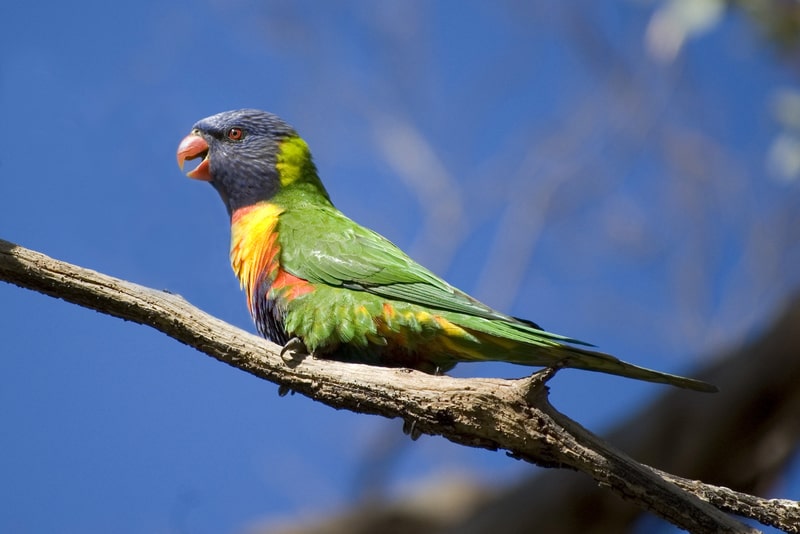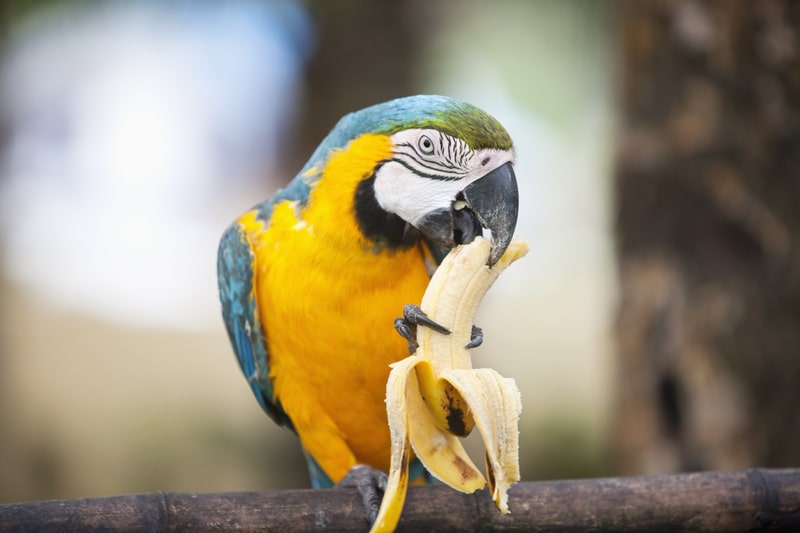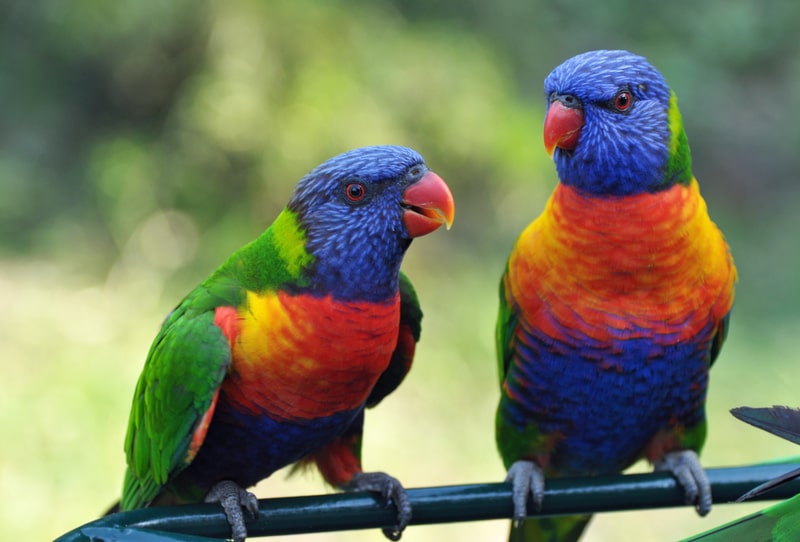Last updated on May 27th, 2023
Parrots are the most popular birds. People cannot resist their bright colors and funny antics. Their quirky personalities make them lovable though demanding companions. They are also undeniably intelligent, with impressive language skills, cognitive abilities, memory retention, and tool utilization. About 50 million parrots live in captivity, usually as house pets. An equal number of these birds roam freely in the wild. Their popularity threatens their existence, as is habitat loss from human activities. Conservation groups lead successful initiatives to curb bird trade, protect forests, and increase their numbers.
50 Interesting facts about parrots
Facts about parrots – origins
1. The diversity of parrots in Australia and South America suggests they originated in the supercontinent of Gondwana before it broke apart. However, parrot fossils are too rare to find supporting evidence for the theory.
2. According to molecular studies, parrots evolved around 59 million years ago. Their ancestors were already present during the dinosaur extinction event. They lived on trees but did not have the crushing bills of modern species.
3. Genomic analysis shows that parrots and passerines are closely related. The latter is a large group of perching birds with an anisodactyl toe arrangement. They include sparrows, blue jays, crows, weavers, finches, and shrikes.

4. Modern parrots may prefer tropical climates, but some of their ancestors flew over Scandinavia. Paleontologists found fossils in Norway and Denmark dating back 55 million years. People call it the Danish Blue Parrot after a BBC Monty Python sketch.
5. The most massive parrot known to science lived 16 million years ago in New Zealand. When it died, it sank to the bottom of the lake, with sand and clay preserving its bones. These suggest a height of 3 feet and a weight of 15 pounds. It initially escaped identification because the size made people assume it was an ancient eagle.
Facts about parrots – anatomy
6. Parrot species have a wide range of sizes. Some are only three inches long and under ten grams in weight. Others stand three feet tall and weigh almost nine pounds – roughly equivalent to a house cat.
7. The most prominent feature of parrots is their curved bill. Broad and powerful, the upper mandible has a downward slope with a pointed end. Large species can use it to generate a dog-like biting force of 500 pounds per square inch.

8. The lower mandible is shorter and sharper. Its cutting edge grinds against the flat section of the upper mandible to slice food. Touch sensors inside the bill help parrots manipulate objects with high dexterity.
9. Parrot eyes face sideways, giving them a wide field of vision. They do not need to turn to see what is above and behind their head, which is useful when avoiding predators. They also have superior frontal vision among birds.
10. It is hard to differentiate between the sexes. Males and females look almost identical, but some have gender-specific plumage visible in the ultraviolet spectrum. Unlike humans, parrots can see UV light.
11. Most birds have four toes: three in front and one at the back. In contrast, parrots are zygodactyl, which means they have a two-by-two configuration for optimum grip. It is like having two opposable thumbs on each hand.

12. Most parrots have green feathers across their bodies. Splashes of other colors occur in small sections. Red, pink, and yellow occur frequently. A few species are predominantly white, gray, or black.
13. Parrot feathers resist long-term damage thanks to a self-defense mechanism against microscopic threats. The birds have bacteria-resistant pigments called psittacofulvins that help maintain their brilliant colors. Exposure to strains has limited effects.
14. Long claws help parrots climb trees and swing on branches. Their feet can also manipulate food, tools, and other objects like humans. One study found that adults have a distinct preference when using their limbs. Some are left-footed, while others are right-footed.
15. Humans have 10,000 taste buds, while parrots only have 300. Some of these are behind their throats, but most are on the roofs of their mouths. Although the number seems small, it is enough to distinguish between options. They prefer some food items over others.

Facts about parrots – behaviors
16. Parrots fly across a wide range in the wild. Scientists study them by placing unique tags on their wings or legs for identification, although many birds notice the foreign objects and chew off their attachments.
17. Most parrot species spend their days perched on tree canopies. It helps them avoid predators while getting a good view of the forest and possible food sources. They can also walk on the ground with a rolling gait if they find something interesting.
18. Parrots are omnivores. Most of their nutrients come from plant sources like fruits, seeds, berries, buds, nuts, pollen, and nectar. However, they can also eat crickets, grasshoppers, mealworms, waxworms, spiders, and silkworms. A few consume clay to release minerals and absorb toxins in the gut.
19. Food preference depends on the size and place. Small parrots in the southern tropics often consume nectar and pollen. They even have brush-tipped tongues to collect these efficiently. Their digestive systems are well-suited for this diet.

20. Many parrot species feed on invertebrate larvae. Others prey on water sails, wood grubs, and insects. Larger ones may be aggressive enough to hunt adult sheep. Some extinct prehistoric parrots had carnivorous diets.
21. Parrots live in tropical and subtropical regions. They fly across Africa, South Asia, Southeast Asia, Oceania, Central America, and South America. The Caribbean and Pacific Islands are also home to endemic species.
22. Parrots introduced to temperate climates successfully survived and maintained stable populations. Some are in Belgium, Spain, Greece, the United Kingdom, and the United States. A few are in the alpine regions of New Zealand and the high mountains of Mexico.
23. Parrots move around, but not too much. Most defy classification as sedentary or migratory because of their erratic movements. Some adopted a nomadic lifestyle to benefit from rich feeding grounds and find better weather.
24. Parrots are social animals. Most of them live in groups in the wild, with some flocks having as many as 30 birds. They communicate vocally by squawking and visually by moving their tail feathers.
25. There is no need for vitamins. Parrots can make calcium supplements using pebbles and date pits to grind cockle shells. After eating and regurgitating the powder, males may offer the mineral-rich snack to females before mating.

Facts about parrots – intelligence
26. Parrots have a brain-to-body ratio comparable to primates, hence their superior intelligence in the animal kingdom. Some do not just repeat words they hear from humans. They can understand the meaning behind these words enough to form simple sentences.
27. Parrots start learning early through social interactions with siblings and parents. They play and search for food together. They may also practice predator evasion during pretend fights. If kept in cages with other animals like chickens, they may adopt the behaviors of their companions.
28. A Harvard-trained parrot named Alex could identify, describe, and count objects using words. He can add two numbers and provide an accurate sum. His math ability is on par with chimpanzees, even understanding the concept of zero.
29. Another parrot named N’kisi demonstrated advanced English skills. It had a vocabulary of nearly a thousand words, which it could use in proper context and correct tense. It could communicate without depending on learned phrases.
30. Griffin, trained in the same lab as Alex the Parrot, outperformed a group of children and Harvard students in a memory test. It consisted of colored pom-poms hidden under cups. Even after switching positions, Griffin guessed where each was better than his human rivals.

Facts about Parrots – breeding
31. Most parrots are monogamous breeders. They develop strong pair bonds while nesting in cavities. The pairs remain close after the breeding season despite joining larger flocks of birds.
32. Parrots attract mates through courtship displays. Males often take the lead by performing a stately walk in front of females. They may also constrict their pupils in an eye blaze. Pairs maintain their bond by cleaning feathers with their beaks.
33. Only a few species build nests in trees or on the ground. Most parrots use tree hollows, cliff holes, or termite nests for shelter. Both parents may excavate to create burrows 0.5 to 2 meters long.
34. Parrots line their nests with plant material for comfort. They use wood chips, dried leaves, and thin sticks. Females remain inside for most of the incubation period, with the males delivering food.
35. Eggs hatch after 17 to 35 days. Newborns often lack feathers, forcing them to spend their first months inside the nest under parental care. They leave once they are strong enough to fly and feed independently.

Parrots as Pets
36. People have been keeping parrots for thousands of years, charmed by their beauty and speaking ability. The ancient naturalist Pliny the Elder wrote about their domestication in the early Roman Empire.
37. Birds are the fourth favorite pet in the US, with over 14 million avians in captivity. Many of these are parrots. Their colorful feathers, acrobatic movements, and fun personalities often lead to impulse purchases in pet shops.
. . . continue reading on the next page
